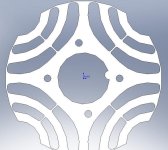bobc
10 kW
Anybody looking at reluctance motors?
Switched reluctance have traditionally been popular in ecar research, (though nothing big commercially)
These should be the easiest (cheapest) motors to make - but they tend to be acoustically noisy because of the magnetic forces on the casing. Stepper motors (e.g. NEMA 17) are switched reluctance
Synchronous reluctance (unfortunately has the same acronym) have recently become popular in industrial drives as they can use a lot of the same tooling and inverter technology as (extremely popular/widespread) induction motors but with no slip, they achieve the now fashionable high efficiency classes that induction motors can't reach.
Synchronous reluctance would seem to have a lot going for it - good efficiency (the main thing,- allows the motor to be small), no use of fancy magnets; yet I never saw anything in the 'press' regarding e-vehicles or ebikes.
For a "tinkerer" in a shed, I'd expect switched reluctance to be a lot easier to make, mostly because of the highly salient stator structure. FWIW I made a synchronous reluctance motor at work a few years ago (before they became a commodity) by getting a sheet of non-directional magnetic steel laser cut (this was for work) and using an induction motor stator - worked pretty good...
Just pointing out that it's not as hard as you might think to actually make real prototypes.!
PS - just saw the thread title "Permanent Magnet....." sorry....
Switched reluctance have traditionally been popular in ecar research, (though nothing big commercially)
These should be the easiest (cheapest) motors to make - but they tend to be acoustically noisy because of the magnetic forces on the casing. Stepper motors (e.g. NEMA 17) are switched reluctance
Synchronous reluctance (unfortunately has the same acronym) have recently become popular in industrial drives as they can use a lot of the same tooling and inverter technology as (extremely popular/widespread) induction motors but with no slip, they achieve the now fashionable high efficiency classes that induction motors can't reach.
Synchronous reluctance would seem to have a lot going for it - good efficiency (the main thing,- allows the motor to be small), no use of fancy magnets; yet I never saw anything in the 'press' regarding e-vehicles or ebikes.
For a "tinkerer" in a shed, I'd expect switched reluctance to be a lot easier to make, mostly because of the highly salient stator structure. FWIW I made a synchronous reluctance motor at work a few years ago (before they became a commodity) by getting a sheet of non-directional magnetic steel laser cut (this was for work) and using an induction motor stator - worked pretty good...
Just pointing out that it's not as hard as you might think to actually make real prototypes.!
PS - just saw the thread title "Permanent Magnet....." sorry....


